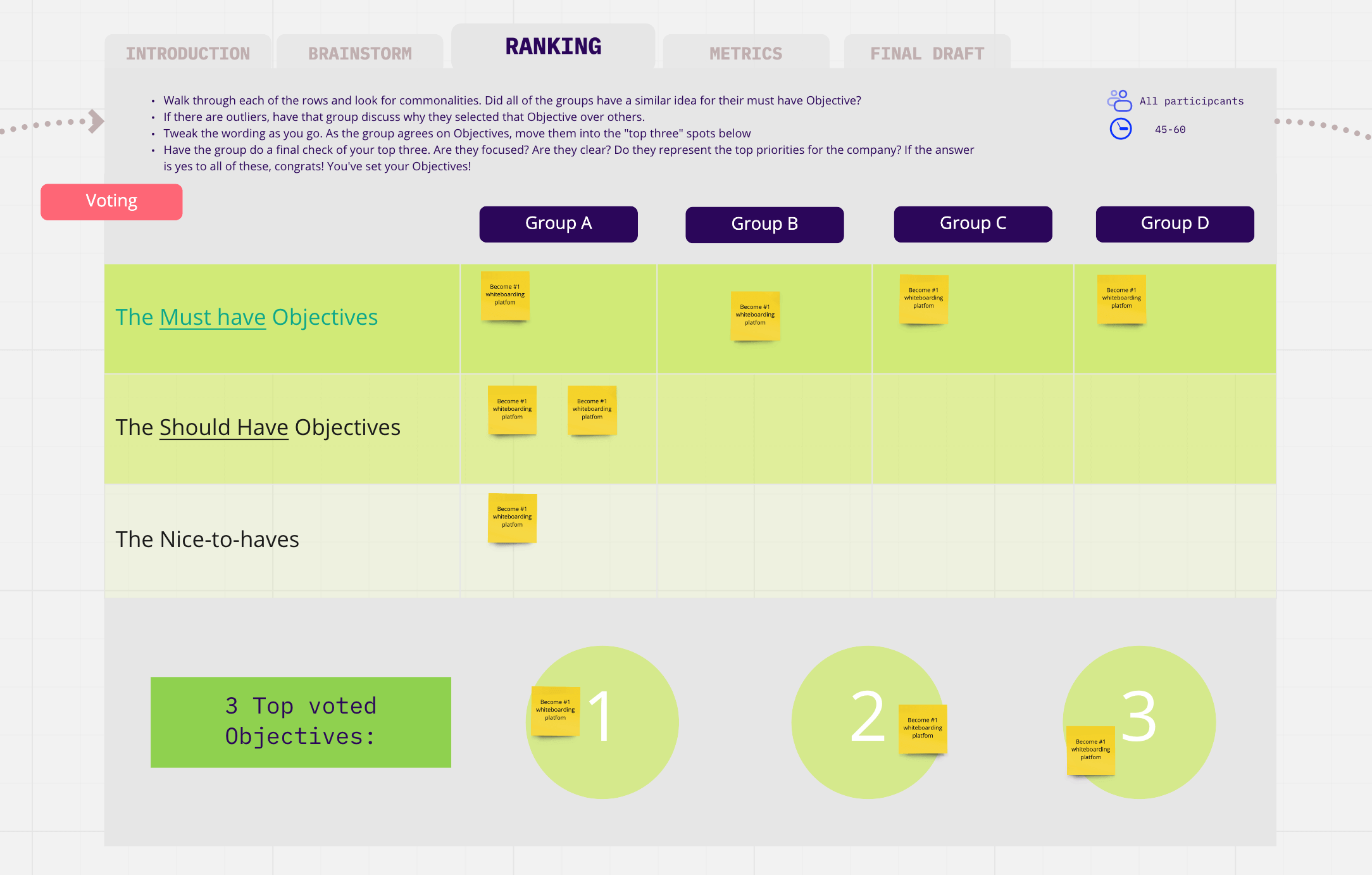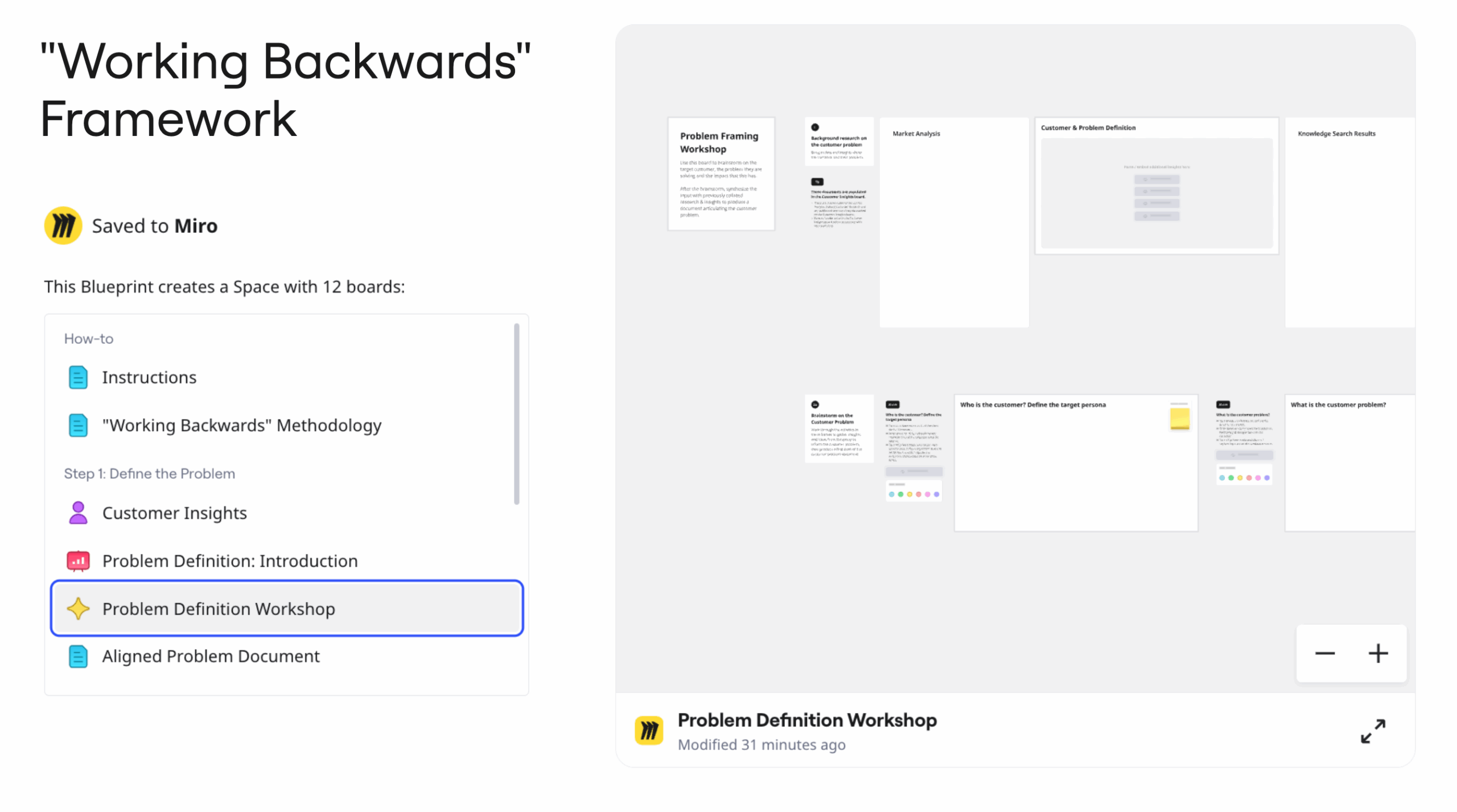“A goal without a plan is just a wish” – Antoine de Saint-Exupery
Whether you do it quarterly, annually, or even weekly, running a planning workshop can be challenging. You need to make sure everyone understands the big picture and vision. You also need to ensure each person has a voice in the planning process. Finally, you need to lead the group to alignment and verify that they’re clear on next steps.
These are the challenges I confronted while leading a goal-setting session at Miro’s recent Executive team offsite (virtual this year). I’m sharing my experience so you can see what worked for us and apply it to your own planning workshop!
Goals of the workshop
We follow a quarterly OKR process at Miro (you can find my OKR template in Miroverse). But I don’t recommend jumping into quarterly planning without first discussing your longer-term goals.
So, this particular session focused on creating company-level objectives that we could use as a guideline for the entire year, revisiting the plan every three months to re-evaluate and re-align. A total of 12 execs across four timezones took part, so I wanted to make sure the time we spent together was productive and efficient.
Explore the workflows, projects, and frameworks of the Miro community
Step 1: Assign prework
Anyone who has run a remote or hybrid workshop knows that preparation and prework are key. Providing the opportunity to do at least some initial thinking asynchronously meant that we could focus on the essential collaborative work during the window of time when we were together.
Before the session, I asked the team to take a critical look at our existing objectives, as well as the state of the business. Each person added some stickies to the board reflecting some things they liked and didn’t like about the goals we’d been using.
I also asked them to review the company’s three-year vision and strategy, which had been created and documented in a previous meeting. This prework was essential for setting the stage for the live OKR meeting.
Step 2: Give context and set ground rules
Once we were all on the same Zoom call, looking at the same Miro board, I ran through some basics. I reminded them about what OKRs were and what they could help us achieve. We looked at examples of good OKRs, including resources from Gitlab and Google, and reviewed feedback from Mironeers about how they felt about the OKR process.
I also set up some ground rules. We would leave the workshop with no more than four OKRs. It’s very easy to get excited and want to achieve a long laundry list of things during the year. But excellent execution comes from focus.
I encouraged folks to assess goals using three criteria:
- Do they represent the most critical things Miro should be working on this year?
- Are they ambitious but focused?
- Are they clear and easy to grasp?
Step 3: Give time for personal reflection
Before I let the execs loose to discuss and debate, I asked them to each spend 10 minutes of personal brainstorming time thinking about what each of us thought our company objectives should be.
I wanted to make sure they were able to collect their own thoughts without being biased by the opinions of others. Groupthink is a real risk during brainstorming sessions, so I recommend including some private reflection time to ensure the group generates the most diverse and innovative ideas. Get more brainstorming ideas in our complete guide.
Step 4: Brainstorm objectives
Use breakout rooms to force prioritization (25 mins)
In my experience, prioritization is the single hardest part of the planning process. After all, we wanted to focus on three or four big things—not add everything to the list. I needed a way for everyone to present and defend their ideas, and to come to a reasonable consensus about which three or four big things we should focus on for the year.
Leveraging a small breakout group format was the single biggest element that made this stage of the planning session successful. For one thing, it would have been nearly impossible to have a productive discussion and make decisions as a group of 12.
Also, the tendency in large groups can be for the loudest voices to dominate, particularly when there is time pressure (say, finalizing draft OKRs within two hours). Having smaller groups helped create a balance where each person could fully express themselves, be heard, and reflect on others’ feedback.
To create this small-group dynamic, we broke the executive team into three four-person Zoom rooms, each with their own frame on the main Miro board. This setup enabled each person to present the ideas they’d jotted down individually, and for the smaller group to meaningfully discuss.

Looking at the image above, you can see that each group has a space to record what they’d decided as the single most important objective at the bottom as a “must-have.” On the second row, there’s space to record the two second-most important objectives. The third row is a dedicated space for “nice-to-haves.”
Step 5: Rank and discuss
Come back to the larger group (45 minutes)
Once each of the small groups had come to a consensus, it was time for everyone to reconvene and present their thoughts to the larger group. On our Miro board, we copied and pasted each of the group’s three levels of objectives, so we could see all ideas as a whole.

This made it easy to see where groups were aligned, and where there were slight differences in opinion. We found that by that point, most of the themes were generally similar. We also gave the opportunity for our CEO, who is the final decision-maker, to weigh in.
Step 6: Brainstorm metrics and key results
With a working idea of our most important goals, it was time to discuss how we’d assess our progress. There are so many options for defining key results, but they should always be specific and measurable.
For this phase of the workshop, I asked each person to add as many potential metrics as they could think of into the column under each objective.
Then, returning to the larger group, I set the Miro timer for 15 minutes for each objective, grouped the metrics, and stack ranked them. From there, we cut down the list to three metrics per objective. These became our key results for the entire year. For each quarter, we will update the number associated with the key result to where we’d like to be at that point in time.
Step 7: Finalize draft objectives
By this stage, we had three objectives and key results the executive group was happy with!
But what about the rest of the company? As a next step, we follow a “W” model for OKR planning, where we share our draft with our functional leaders for bottoms-up feedback, then adjust as necessary, then share with the broader company so each department can set their own goals. For these next steps of org-wide OKR planning with all departments represented, you can use my OKR template.
Planning is an iterative process
While we don’t expect our objectives to change much during the course of the year, we still start every quarter by reviewing our objectives and checking in—based on what we know today, are these still the most important things we could be working on? Are these objectives clear?
Once we have the objectives in place, we assess the key results (KRs), where most of the quarterly changes take place. We’ll make sure the metrics we’ve chosen are still the right ones and then update the numerical value for each one.
OKRs are a directional tool—they aren’t written in stone, you’re meant to make tweaks to them based on what you learn each quarter. That means the framework is working!
Try the Company Goal-Setting Workshop Template




